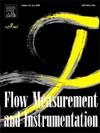Real-time reconstruction of a slug regime with a collimated infrared transceiver
IF 2.3
3区 工程技术
Q2 ENGINEERING, MECHANICAL
引用次数: 0
Abstract
Two-phase flows are indispensable in the design of nuclear reactors, space thrusters, heat exchangers, micro total analyzers, and micro-reactors. The present work investigates the irradiation behavior of an infrared (IR) transceiver equipped with a bi-convex lens and its impact on characterizing specific two-phase flow regimes. The study focuses on slug flow in a 3 mm diameter glass tube. The limitations associated with conventional conical IR projections from an IR transceiver are addressed by employing a single-sensor configuration of a collimated IR beam. A novel technique is proposed to relate the measured current signal with liquid film thickness, enabling a real-time two-dimensional and three-dimensional reconstruction. The study highlights the potential of IR-based techniques for real-time monitoring of two-phase flow regimes in three dimensions.
利用准直红外收发器实时重建段塞流状态
在核反应堆、空间推进器、热交换器、微总量分析仪和微反应堆的设计中,两相流是不可缺少的。本工作研究了配备双凸透镜的红外收发器的辐照行为及其对表征特定两相流型的影响。研究的重点是直径为3mm的玻璃管内的段塞流。通过采用准直红外光束的单传感器配置,解决了与红外收发器的传统锥形红外投影相关的局限性。提出了一种将测量电流信号与液膜厚度联系起来的新技术,实现了实时的二维和三维重建。该研究强调了基于红外的技术在三维实时监测两相流流型方面的潜力。
本文章由计算机程序翻译,如有差异,请以英文原文为准。
求助全文
约1分钟内获得全文
求助全文
来源期刊

Flow Measurement and Instrumentation
工程技术-工程:机械
CiteScore
4.30
自引率
13.60%
发文量
123
审稿时长
6 months
期刊介绍:
Flow Measurement and Instrumentation is dedicated to disseminating the latest research results on all aspects of flow measurement, in both closed conduits and open channels. The design of flow measurement systems involves a wide variety of multidisciplinary activities including modelling the flow sensor, the fluid flow and the sensor/fluid interactions through the use of computation techniques; the development of advanced transducer systems and their associated signal processing and the laboratory and field assessment of the overall system under ideal and disturbed conditions.
FMI is the essential forum for critical information exchange, and contributions are particularly encouraged in the following areas of interest:
Modelling: the application of mathematical and computational modelling to the interaction of fluid dynamics with flowmeters, including flowmeter behaviour, improved flowmeter design and installation problems. Application of CAD/CAE techniques to flowmeter modelling are eligible.
Design and development: the detailed design of the flowmeter head and/or signal processing aspects of novel flowmeters. Emphasis is given to papers identifying new sensor configurations, multisensor flow measurement systems, non-intrusive flow metering techniques and the application of microelectronic techniques in smart or intelligent systems.
Calibration techniques: including descriptions of new or existing calibration facilities and techniques, calibration data from different flowmeter types, and calibration intercomparison data from different laboratories.
Installation effect data: dealing with the effects of non-ideal flow conditions on flowmeters. Papers combining a theoretical understanding of flowmeter behaviour with experimental work are particularly welcome.
 求助内容:
求助内容: 应助结果提醒方式:
应助结果提醒方式:


